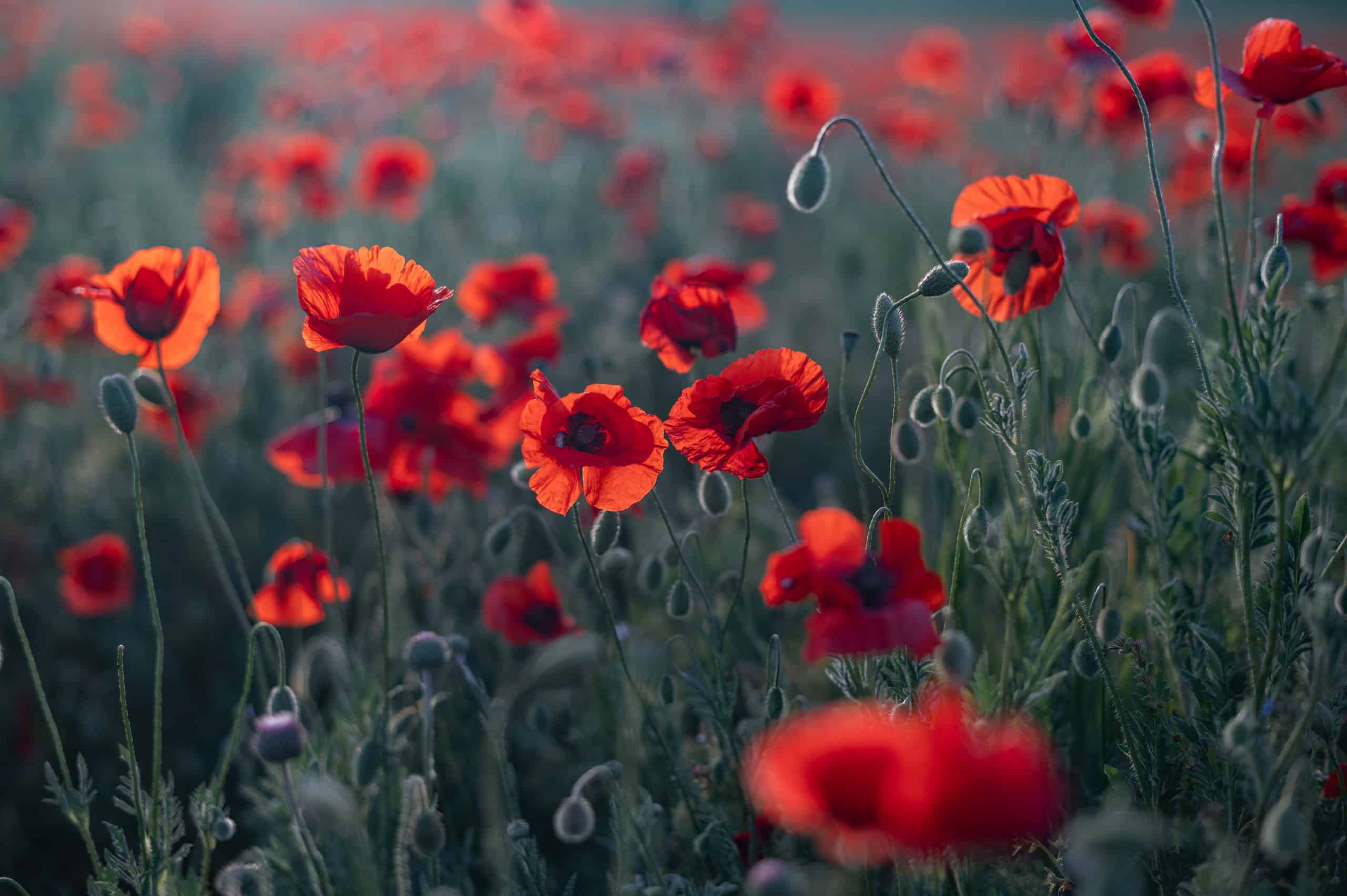Delicate yet standing tall in meadows across the world, the colorful blossoms of poppy flowers gracefully sway in the gentle breeze. Prized both for their rich symbolism as well as their unique attributes poppies have interwoven themselves into our own human history. From medicine and poppyseed muffins to war memorials and Dorothy’s journey in The Wizard of Oz, poppies continue to enchant us with their beauty and hidden mysteries. Let’s take a closer look at the meaning and symbolism of the poppy flower!
What Is a Poppy Flower?

Poppy seeds are highly toxic to dogs.
©Joaquin Corbalan P/Shutterstock.com
A member of the esteemed Papaveraceae family and Papaveroideae subfamily, the poppy is a delicate flowering plant with an undeniable charm. With over 100 different species living within tropical and temperate realms across the earth, the poppy is not only a beautiful wildflower but one with remarkable versatility and resilience. Each variation possesses its own unique allure, showcasing an exquisite blend of different sizes, shapes, and colors.
Humans have cultivated and grown poppies for thousands of years, even as far back as 6,000 to 3,500 BCE! We still frequently use poppies today, both for the beauty they add to gardens as well as for their nutritional value and medicinal properties. For example, if you enjoy poppy seed muffins or bagels, you are actually eating tiny seeds from a poppy flower! With their tiny size and uniquely nutty flavor, seeds from the opium poppy (Papaver somniferum) are a common ingredient in baking and cooking — but don’t worry, the seeds are thoroughly cleaned, so they no longer have any opium on them!
Appearance
Poppy flowers come in a myriad of shapes, sizes, and colors, but they all retain similar characteristics. Each poppy flower has four to six thin and delicate petals with a special crepe-like texture. Although the most common poppy color is red, different varieties span across an enchanting variety of red, white, orange, yellow, purple, and blue poppies.
For example, oriental poppies (Papaver orientale) grow up to 12 inches in diameter with hues of crimson, orange, and golden yellow. Alpine poppies (Papaver alpinum), on the other hand, have small flowers that come in many beautiful colors like white, pink, orange, yellow, and red.
Native Habitat
Poppy flowers grow all over the world, although some species are native to specific areas. The opium poppy, For example, is native to the Mediterranean region, while Iceland poppies come from colder regions in Asia and Europe.

The petals of poppy flowers are incredibly unique, with a thing and crinkly crepe-like texture.
©Beach Creatives/Shutterstock.com
Growing Tips
With their resilient nature and abundant seeds, poppies are typically quite easy to grow. However, they don’t like humid conditions or wet soil, so it’s best to plant poppies where they’ll get plenty of sun. Poppy seeds are tiny (just think of those little poppy seeds on your bagel!). So, it can be helpful to mix them with sand or a potting mix. This makes it easier to sprinkle them evenly wherever you are planting them.
Poppy flowers are more delicate during their germination phase, so they will need a little more moisture. However, as they begin to blossom, you’ll need to scale back watering. Once established, your poppy flowers will become quite content with limited watering. If they receive too much water, they can grow excessively leggy and tall, so it’s important to strike the right balance. In addition, poppies are susceptible to various fungal issues if their leaves and petals are too moist, so watering them at the base is best.
To keep your poppies happy and healthy, aim to water them once a week. You can stick your finger into the soil surrounding your plants, and if it feels damp, hold off on watering. However, if it’s dry and crumbly, your poppies could use a drink.

Poppy Flower Meaning and Symbolism
Sleep and Dreams
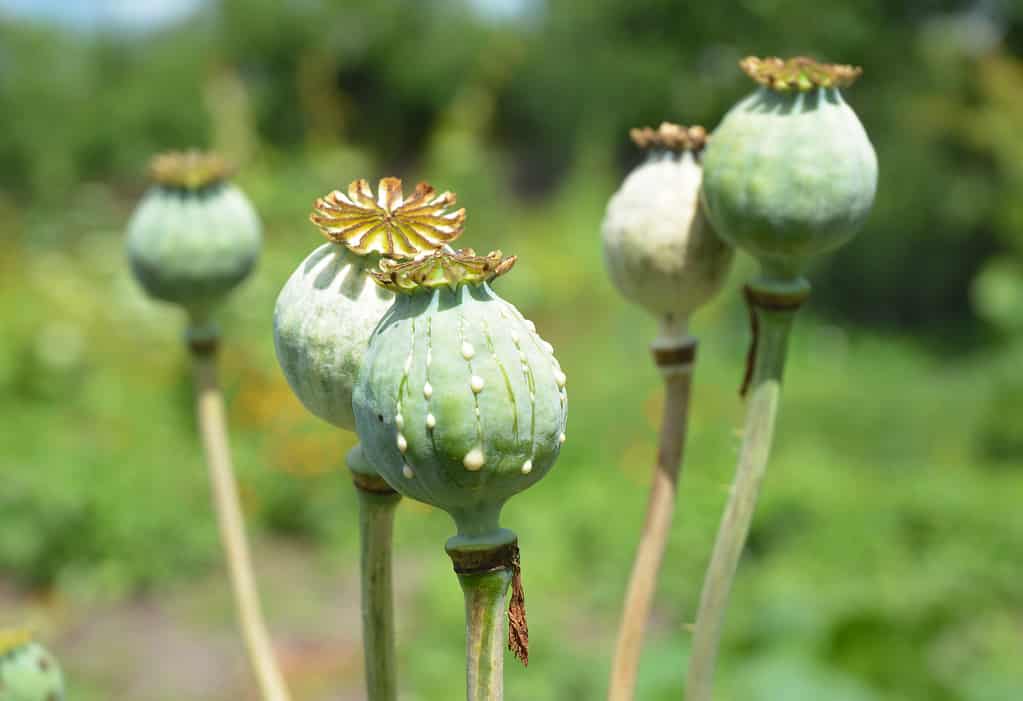
The seed pods of opium poppies house a unique milky substance that is used to make morphine.
©Lex20/iStock via Getty Images
Throughout history, poppies have held a special place in the human imagination due to the unique substance hidden within their delicate seed pods. It is a special kind of milk called opium, and it has been used since ancient times. In fact, opium is one of the oldest human medicines! It has been used for centuries to help bring relief to those suffering from pain, and to help people drift off into a peaceful sleep. Today, people still use opium poppies to make morphine. In fact, morphine takes its name from Morpheus, the ancient Greek god of sleeping dreams.
Poppies are also associated with several other gods and goddesses in ancient Greek mythology. Hypnos, the god of sleep, often holds a poppy or places poppy flowers on someone’s head to help them sleep. Demeter, the goddess of agriculture, also used poppies to help people to sleep and to find rest from their troubles.
Poppies also play an important role in the story of The Wizard of Oz. On their way to see the wizard, Dorothy, and her friends cut through a large field of scarlet-colored poppies. Created by the Wicked Witch of the West to keep them from reaching Oz, the powerful fragrance of the poppies lulls the group to sleep.
Death and Rebirth
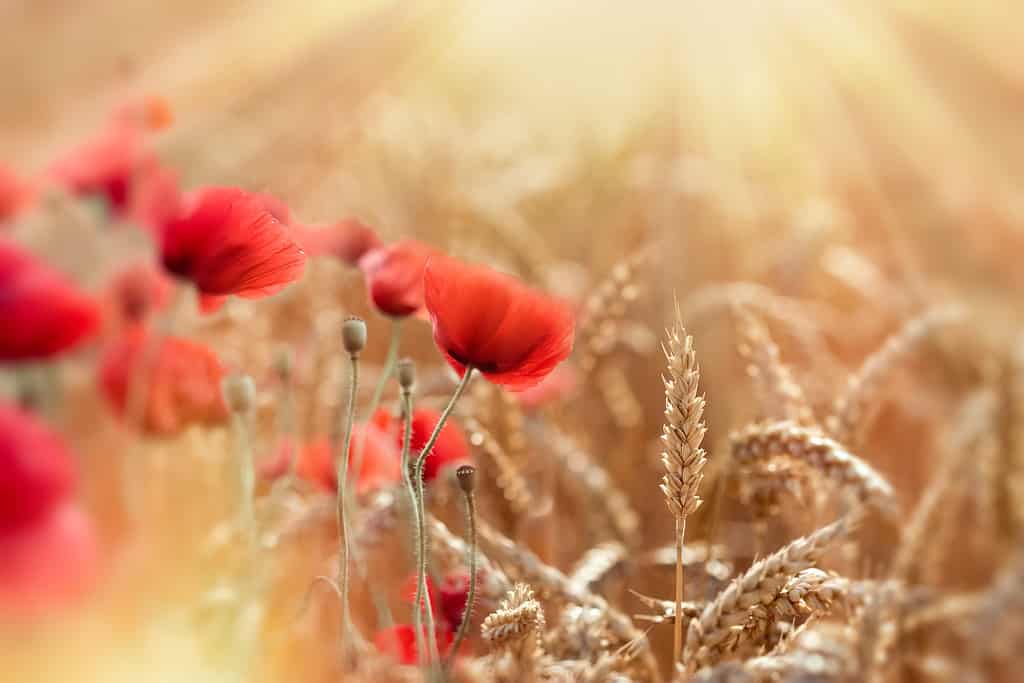
After harvesting the corn, the leftover poppies looked like splashes of blood dotting the landscape in ancient Egypt.
©lola1960/iStock via Getty Images
Alongside their symbolism of sleep and dreams, poppies also serve as symbols of death and rebirth. For example, corn poppies or field poppies (Papaver rhoeas) are common in ancient Egyptian art, elaborate jewelry, bouquets, and tombs. The ancient Egyptian god of death, Osiris, was also associated with poppies. These crimson-colored flowers grew in the cornfields of ancient Egypt. In the spring when the corn was planted once again, the beautiful poppies would return, as if resurrected from the dead. After his death, King Tutankhamun was dressed in ceremonial clothing containing poppy plants, and artistic depictions of poppies decorated his tomb.
In ancient Greek mythology, Thanatos, the god of death, often wears a crown of poppies. The people also included poppies in their offerings to the dead. Poppies and pomegranates are also the main symbols associated with Persephone, the daughter of the goddess Demeter. In some accounts, Persephone had an enormous garden growing in the underworld, which was filled with continually blooming poppy flowers. Her poppies could induce a waking sleep, trapping wanderers in the Underworld as long as they were holding them. However, the poppies also symbolize her eventual return to the world above to see her mother each spring.
Remembrance
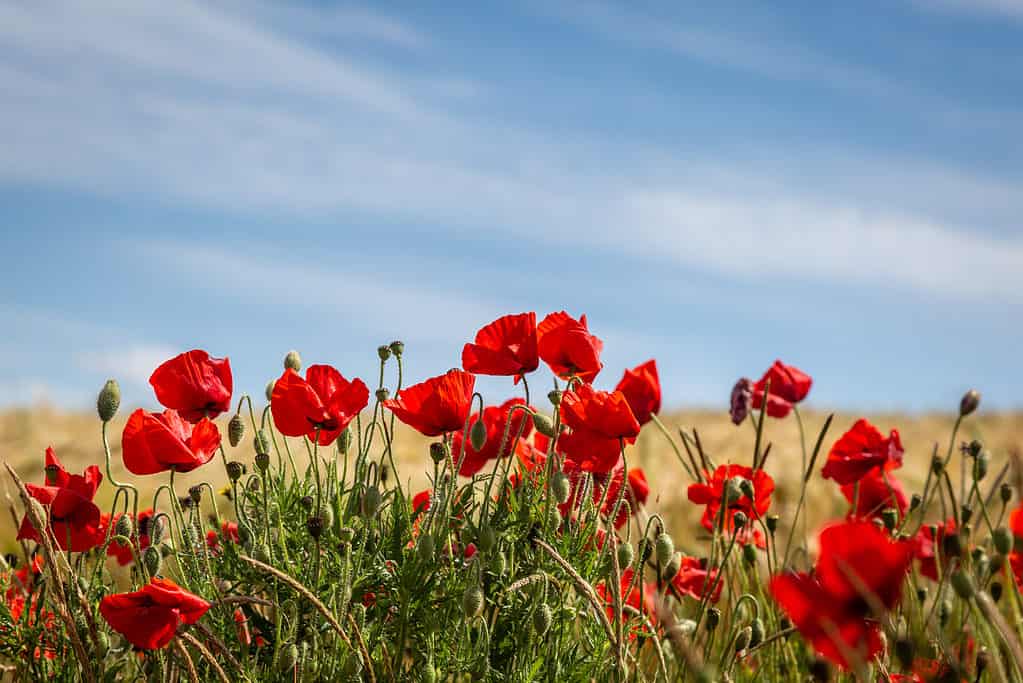
Red poppy flowers dot the landscapes where many World War I battles were fought.
©iStock.com/Lemanieh
One of the most prominent examples of the meaning and symbolism of the poppy flower today began during World War I. Memorials all across Europe, Canada, and Australia often include bright red poppy blossoms, as they have become the ultimate symbol to remember veterans who gave their lives during the war.
Lieutenant-Colonel John McCrae volunteered to serve as a surgeon during World War I. The Canadian soldier was present at the horrendous Second Battle of Ypres in 1915. Although he treated many of the wounded, one of his friends still died during the battle. As the fighting continued on, tiny red poppies sprung up within just days of burying the dead, covering the battle-torn landscape. The emotional scene is depicted in the first lines of McCrae’s famous poem, “In Flanders Fields”, as he writes, “In Flanders Fields, the poppies blow / Between the crosses, row on row…”
The poem is written in first person as if the dead soldiers themselves are calling out to those still living. McCrae ends the poem with the message that if those still living do not take up the torch, those who sacrificed their lives “shall not sleep, though poppies grow / In Flanders Fields”. His poem was such a poignant description and powerful call to action that it was used by countries around the world to sell war bonds and help with fundraising for the war.
It is hard to say exactly how many soldiers died during the Second Battle of Ypres, but estimates range from 58,000 to 90,000. Countless cemeteries now line the area where these battles were fought, and if you visit any one of them, you will find red “remembrance poppies” placed along the headstones.
Meaning and Symbolism of Poppy Flower Colors
Red Poppy Flowers
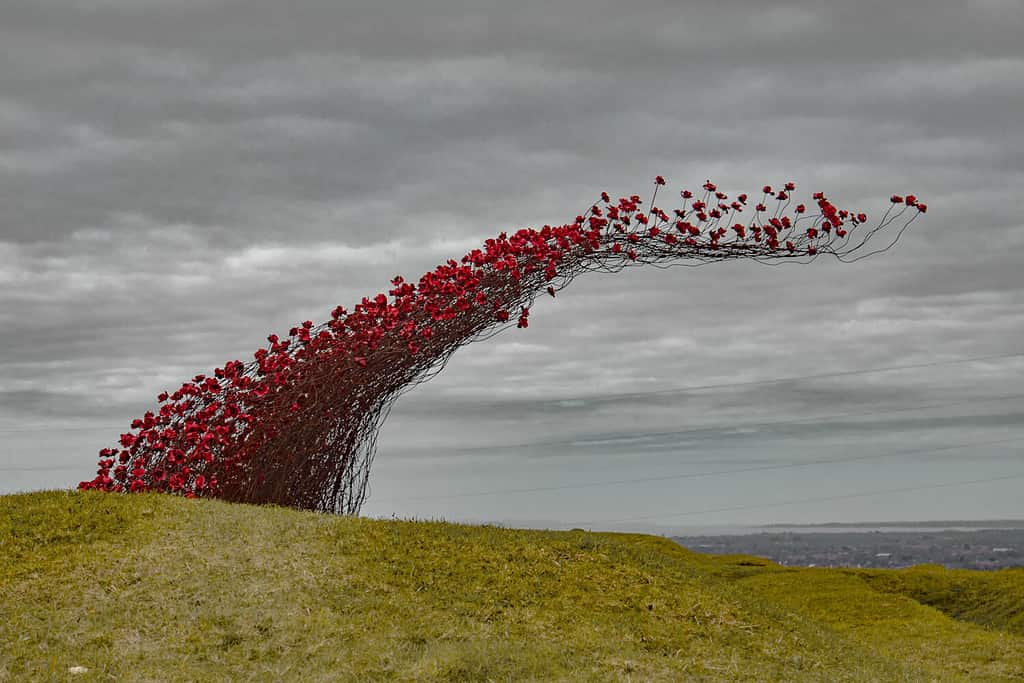
, is an installation art piece honoring the lives lost during World War I.
©Mark Gray Photography/Shutterstock.com
As previously mentioned, red poppies most commonly symbolize remembrance, particularly honoring those lost during World War I. England’s Poppy Factory in Richmond, London, still produces red poppy remembrance wreaths today. The factory was established in 1922 as a way to both honor the sacrifices of the soldiers during the war and to provide employment for those who were wounded. In fact, the iconic “remembrance poppies” were designed so that disabled soldiers could still make them with only one hand.
In addition to symbolizing the remembrance of the Great War, red poppies also embody hope. A resilient flower that thrives even in impoverished soil, red poppies gracefully bloom during spring — a season of rebirth. Wearing a red poppy holds a special significance, transcending nationality, military service, or political beliefs. It carries the weight of tribute to those who bravely served and made the ultimate sacrifice in war, while also serving as a solemn reminder to strive for peace.
Black Poppy Flowers
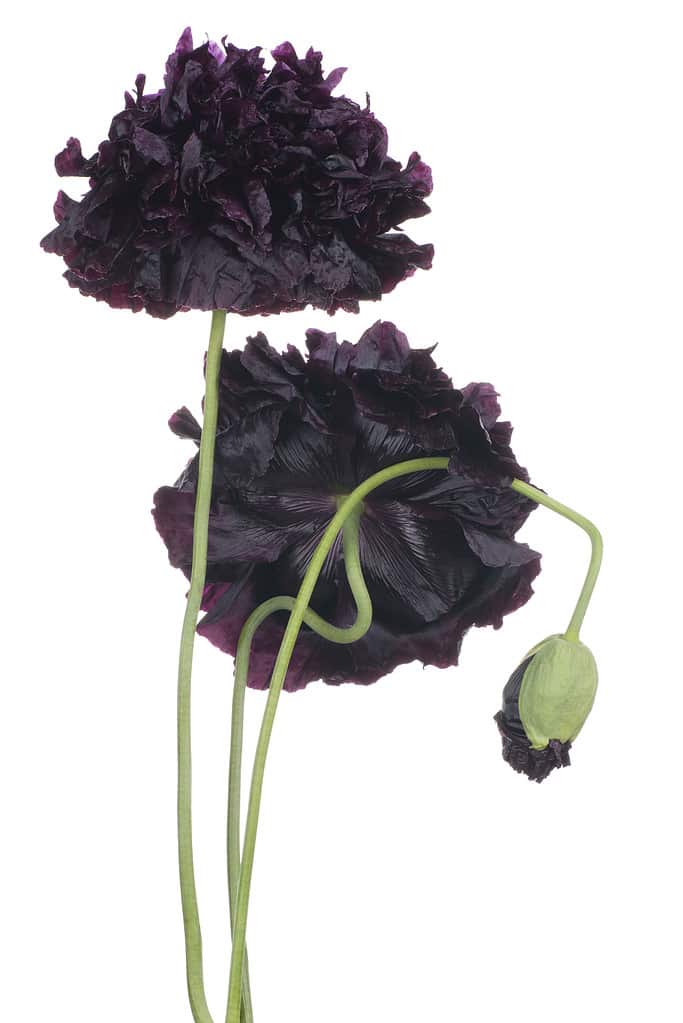
Although rare, there are a handful of black poppy flowers, like the
Papaver somniferum‘Double Black’.
©_Vilor/iStock via Getty Images
Like red poppies, black poppies have also become symbolic of remembering those who have died in war. However, black poppies are not specifically tied to World War I. The BlackPoppyRose, a charitable organization that combines both the black poppy and a red rose, uses these flowers to commemorate and honor the often untold stories of civilians as well as servicemen and servicewomen from black, African, and Caribbean communities.
White Poppy Flowers

The Pua Kala or Hawaiian poppy (
Argemone glauca) is native to Hawaii.
©RukiMedia/Shutterstock.com
In Western cultures, white poppy flowers stand as symbols of peace. Many people wear white poppies on Remembrance Day, in honor of those who lost their lives in battle. However, white poppies are also a powerful reminder of peace. They symbolize a challenge to how we perceive war and focus on a future of peace.
Purple Poppy Flowers

Many people place wreaths with purple poppies alongside the traditional red ones to honor non-human animals.
Another solemn symbol of remembrance, the purple poppy flower honors the brave animals who fell victim to the ravages of war. Loyal horses, faithful dogs, and brave pigeons were called upon, and their service was deemed worthy of recognition and honor alongside their human counterparts. Among them, countless equine companions perished or suffered injury during World War I, as depicted in the novel, screenplay, and film, War Horse.
Blue and Pink Poppy Flowers
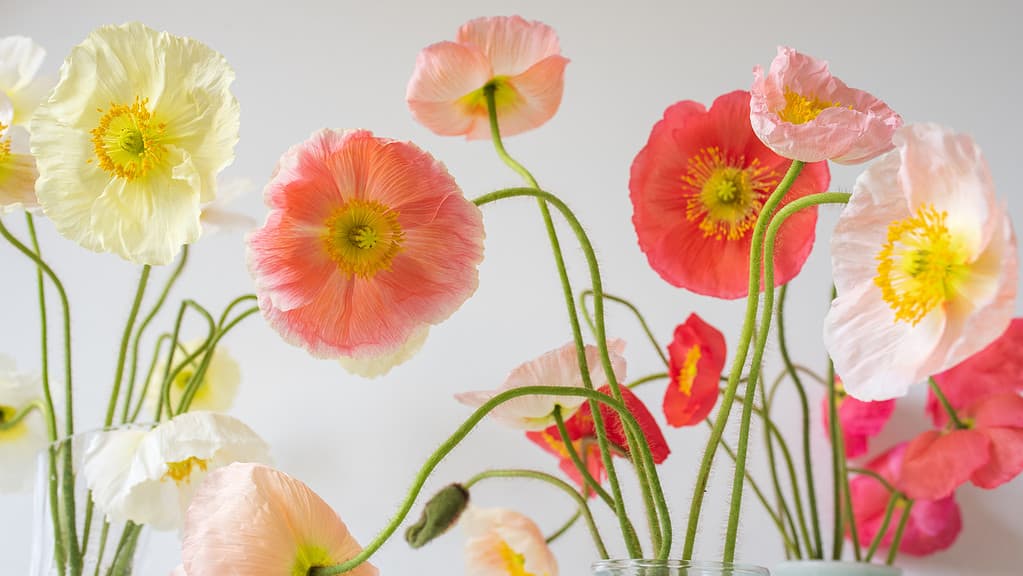
Poppy flowers come in beautiful colors, including many lovely shades of pink.
©natalie_board/iStock via Getty Images
Pink poppies are symbols of kindness, compassion, and platonic love. Their beautiful pink hues link to the heart chakra, connecting to the divine and one’s inner self. Blue and pink poppies can also symbolize imagination, success, and luxury.
Orange Poppy Flowers
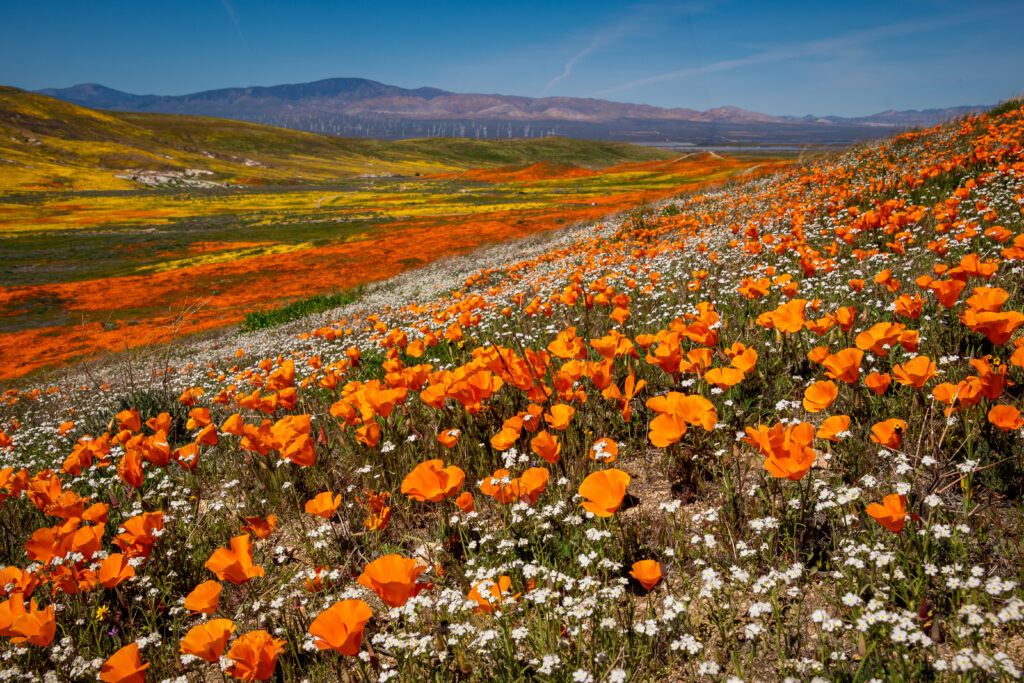
California poppies (
Eschscholzia californica) are a beautiful golden-orange color.
©MierCat Photography/Shutterstock.com
A symbol of health, resilience, and rebirth, orange poppies serve as gentle reminders of our capacity to heal from wounds inflicted by the many challenges in life. Some people also wear orange poppies to symbolize and raise awareness of mental health issues and trauma.
Yellow Poppy Flowers

Although beautiful, the yellow-horned poppy (
Glaucium flavum) is a toxic plant.
©Primi2/Shutterstock.com
With their vibrantly colored petals, yellow poppy flowers embody a profound sense of optimism and the capacity to find solace even in dark moments. They also serve as reminders of the happy memories of loved ones who have departed this life. Yellow poppies also gently remind us that through the depths of darkness, we can still find a glimmer of light and hope.
Proper Occasions for Poppy Flower
Remembrance
In many countries like Canada, the United Kingdom, New Zealand, and Australia, poppies are common on solemn occasions such as Armistice Day or Remembrance Day. Red poppies in particular are a heartfelt tradition and serve as poignant symbols honoring the courageous soldiers who made the ultimate sacrifice during World War I. Poppies are commonly used to honor veterans on Remembrance Day, Armistice Day, Veterans Day, Memorial Day, and ANZAC Day.
Peace and Hope
As symbols of peace and hope, poppies gracefully bloom across lands that were once ravished by war. They flourish in the tender embrace of spring, reminding us of the indomitable resilience of the natural world and the human spirit. A symbol of renewal and new beginnings, poppies can be used to encourage us to embrace healing and reconciliation as we work to build a future of peace and hope.
Funerals and Memorials
Both bright and delicate, poppy flowers evoke a sense of solace, remembrance, and acceptance. Often linked with honoring fallen heroes, poppies are popular and poignant tributes to lives lived and sacrifices made. Their vibrant colors also reflect the intensity of emotions that we experience during moments of grief and loss. Poppies offer a temporary sanctuary from the burdensome weight of sorrow, reminding us that although life is fleeting, beautiful and cherished memories remain.
Gifts
With their striking colors and whimsical blossoms, poppies are charming flowers that can brighten even the gloomiest days. Giving someone a bouquet of poppies can lift their spirits and remind them of their own beauty, resilience, and strength. In addition, poppies and poppy-themed gifts can be great choices for someone from California, as the California state flower is the California poppy. They are also excellent gifts for those born in August, as they are one of the month’s official birth flowers.
Thank you for reading! Have some feedback for us? Contact the AZ Animals editorial team.

